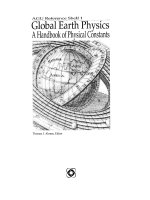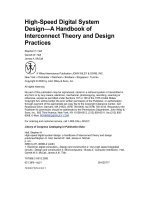Ebook A Handbook of spectroscopic data chemistry Part 2
Bạn đang xem bản rút gọn của tài liệu. Xem và tải ngay bản đầy đủ của tài liệu tại đây (7.52 MB, 144 trang )
4
13e NMR Spectroscopy
4.1: The 13C chemical shifts of Linear and Branched Alkanes:
Alkane groups unsubstituted by heteroatoms absorb downfield from
TMS to about 60 ppm. (Methane absorbs at 2.5 ppm upfield from TMS.)
Within this range we can predict the chemical shifts of individual 13C atoms in
a straight chain or branched chain hydrocarbon from the data in Table 4.1 and
the formula b = -2.5 + LnA.
Where b = Predicted shift for a carbon atom.
A = Additive shift parameter.
n = number of carbon atoms for each shift parameter (-2.5 is the shift
of the i3C of methane).
The calculated (and observed) shifts for the carbon atoms of
3-methylpentane are
/+ 19.3 (18.6)
6
CH 3
I
I
CH 3 -
I
+ 11.3
(+11.3)
2
3
CH 2 -
CH- CH 2 -
\
+29.5
(+29.3)
4
"
+ 36.2
(+ 36.7)
5
CH 3
100
Spectroscopic Data Chemistry
For carbon atom I, we have la,
° =-2.5 + (9.1
1
x
I) + (9.4
x
I~-,
2y and 1&-carbon atoms.
I) + (-2.5
x
2) + (0.3
x
I)
=
+ 11.3
Carbon atom 2 has 2 a-, 2 ~-, and 1 y carbon atoms. Carbon atom 2 is
a 2° carbon with a 3° carbon attached [2°(3°) = - 2.5]
°
2
=-2.5 + (9.1 x 2) + (9.4 x 2) + (-2.5 x 1) + (-2.5 x 1) = 29.5
Carbon atom 3 has 3 a- and 2 ~- carbon atoms, and it is a 3° atom with
two 2° atoms attached [3° (2°) = -3.7]. Thus 03 = -2.5 + (9.1
+ (-3.7
x
x
3) + (9.4 x 2)
2) = + 36.2
Carbon atom 6 has, I a-, 2~-, and 2y carbon atoms, and it is a 1° atom
with a3° atom attached [10 (3°) =-1.1]. Thus,
+(-2.5x2)+(-1.l
x
°=-2.5 +(9.1 x 1)+(9.4 x 2)
6
1)=+19.3
The agreement for such calculations is very good. It is essential that the
reference compounds used for such additivity culculations be structurally similar
to thecompound of interest.
Table 4.1: The \3C shift parameters in some linear and branched
hydrocarbons
13C
Atoms
Shift (ppm) (A)
a
+9.1
p
+9.4
Y
b
-2.5
E
+0.1
+0.3
1° (3?
-1.1
1° (4°)"
20 (3 o)a
-3.4
20 (4°)
-7.2
3° (2°)
-3.7
3° (3°)
-9.5
4° (10)
-1.5
4 ° (2°)
-8.4
-2.5
101
I3C NMR Spectroscopy
a
The notations 1° (3°) and 1° (4°) denote a CH 3 group bound to a R2CH
group and to a R3C group, respectively. The notation 2° (3°) denotes a RCH 2
group bound to a ~CH group, and so on.
Table 4.2 lists the shifts in some linear and branched alkanes.
Table 4.2: The \3C Shifts for some Linear and Branched chian Alkanes
(ppm from TMS).
Compound
C-l
C-2
C-3
Methane
-2.3
Ethane
5.7
Propane
15.8
16.3
15.8
Butane
13.4
25.2
25.2
Pentane
13.9
22.8
Hexane
14.1
Heptane
C-4
C-5
34.7
22.8
13.9
23.1
32.2
32,2
23.1
14.1
23.2
32.6
29.7
32.6
Octane
14.2
23.2
32.6
29.9
29.9
Nonane
14.2
23.3
32.6
30.0
30.3
Decane
14.2
-23.2
32.6
31.1
30.5
Isobutane
24.5
25.4
Isopentane
22.2
31.1
32.0
11.7
lsohexane
22.7
28.0
42.0
20.9
Neopentane
31.7
28.1
2,2-Dimethylbutane
29.1
30.6
36.9
8.9
3-Methylpentane
11.5
29.5
36.9
(18.8,3CH)
2,3-Dimethylbutane
19.5
34.3
2,2,3-Trimethyl
27.4
33.1
38.3
16.1
7.0
25.3
36.3
(14.6,3-CH 3)
butane
2,3-Dimethylpentane
14.3
102
Spectroscopic Data Chemistry
Table 4.3: Incremental Substituent Effects (ppm) on Replacement ofH by
Y in Alkanes. Y is Terminal or Internal" (+ downfield, -upfield)
y
...
~y'"
~
Terminal
Y
a
Internal
~
y
Terminal
Internal
Terminal
Internal
+9
+6
+10
+8
-2
CH3
CH=CH2
+20
+6
-0.5
+4.5
+5.5
-3.5
C=CH
+2
COOH
+21
+16
+3
-2
COO-2
+25
+20
+5
+3
+2
-2
COOR
+20
+17
+3
+33
+28
+2
COCI
+22
CONH2
-0.5
+2.5
+30
+24
+1
+1
-2
COR
-2
CHO
+31
0
Phenyl
+23
+17
+9
+7
-2
+48
+41
+10
+8
-5
OH
+58
+51
+8
+5
-4
OR
+51
+45
+6
+5
-3
OCOR
-5
+29
+24
+11
+10
NH2
-5
NH3+
+26
+24
+8
+6
+8
+6
-4
NHR
+37
+31
+42
-3
N~
-7
+31
+5
NR/
+4
+4
N0 2
+63
+57
+3
-3
+4
+1
+3
CN
+11
+11
+12
+11
-4
SH
-3
+20
+7
SR
-F
+6
-4
+9
+68
+63
+31
+32
+11
+10
-4
CI
+ 11
+20
+10
-3
Br
+25
-1
+4
+11
+12
I
-6
a Add these increments to the shift values ofthe appropriate carbon atom in
Table 4.2 or to the shift value calculated from Table 4.1.
From Table 4.3, the approximate shifts for the carbon atoms of, for example,
3-pentanol, may be calculated from the values for pentane in Table 4.2; that
I1C NMR Spectroscopy
103
is, the increment for the functional group in Table 4.3 is added to the appropriate
value in Table 4.2 as follows:
y
f3
a
CH 3 -
CH 2 -
CH- CH 2 I
f3
y
CH 3
OH
Ca
CI3
Cy
Calculated
Found
34.7 + 41 = 75.8
22.8 + 8 = 30.8
13.9 - 5 = 8.9
73.8
30.0
10.1
The chemical shifts of the CH 2 groups in monocyclic alkanes are given in
Table 4.4. Each ring skeleton has its own set of shfit parameters. Rough estimates
for substituted rings can be made with the substitution increments in Table 4.3.
Table 4.5 presents chemical shifts for several saturated heterocyclics.
Table 4.4: Chemical shifts of Cycloalkanes (ppm from TMS)
C3 H6
C4HS
CsHIO
C6 HI2
C7H I4
CgH I6
CgH 1S
C 1oH20
-2.9
22.4
25.6
26.9
28.4
26.9
26.1
25.3
Table 4.5: Chemical shifts for saturated Heterocyclics (ppm from TMS,
neat) Unsubstituted
0
U
D
29.7
H
N
S
39 .5
27.5
6
18 .7
U
65
12
68.4
31.7
0 0
S
18 .2
S
22.9
0
0
N
H
72.6
57
47.1
104
Spectroscopic Data Chemistry
24.9
26.6
0
o
0
27.7
/' 69.5
25.9
0
27.8
29.1
N
H
S
Substituted
o
0
~CH3
47.3 /
\
47.6
27.8
47.9
24.4
567
N
CH3
48.0
18.1
4.2 Alkenes and Alkynes
The Sp2 carbon atoms of alkenes substituted only by alkyl groups, absorb
in the range of about 11 0-150 ppm downfield from TMS. The double bond
has a rather small effect on the shift of the Sp3 carbon in the molecule. Calculation
of approximate shifts can be made from the following parameters where (a, ~,
and y represent substituents on the same end of the double bond as the alkene
carbon of interest, and (a', W, and y' represent substituents on the far side.
a
+10.6
~
+7.2
Y
-1.5
a'
-7.9
~'
·-1.8
y'
-1.5
Z (cis) correction
-1.1
These parameters are added to 123.3 ppm, the shift for ethylene. We can
calculate the values for cis-3-methyl-2-pentene as follows:
a
CH3H
P a
H3 C-CH 2 5
0C_3
4
I
I
a
C = C -CH3
3
2
I
= 123.3 + (2 x 10.6) + (l x 7.2) + (l x -7.9) - 1.1
= 142.7 ppm.
a'
CH3H
W a'
H,C-CH 2 Os
0C_2 =
4
123.3 + (I
-<
I
I
C =C
3
2
a
-cI H3
10.6) + (2 x -7.9) + (I x 1.8) -- l.l
=
115.2 ppm.
The measured values are C-3 = 137.2 and C-2 = 116.8. The agreement
is fair. The allylic carbon of a (Z) alkene is usually at lower field from that of
IlC NMR Spectroscopy
lOS
an (E) alkene by about 4-6 ppm. Alkene carbon atoms in polyenes are treated
as though they were alkane carbon substituents on one of the double bonds.
Thus in calculating the shift ofC-2 in I A-pentadiene, C-4 is treated like a 13spJ carbon atom.
Representative alkenes are presented in Table 4.6.
There are no simple rules to handle polar substituents on an alkene carbon.
Shifts for several substituted alkenes are presented in Table 4.7.
The central carbon atom (=C=) of alkyl substituted allenes absorbs far
downfield in the range of about 200-·215 ppm, whereas the terminal atoms
(C=C=C) absorb upfield in the range of about 75-97 ppm.
Table 4.6: Alkene and Cycloalkene Chemical shifts (ppm from TMS)
111 ,
H2C=CH~
Iic/C~""'Gr~Ci:i2
I".'
I·HJ .1
,
11-11
H,C "cH(CI~"at~CH,
"XI
, .?_~ 7
1175
t~C"
~rn
1112
~,
CH,
-
Spectroscopic Data Chemistry
106
J 14 ~
I ~') .:;
HF, /GI~
ill
"CH-CH 1
1.17 M
13-' 2
121\.l
127A 123 I
J .125
172
12 H
IIW.
H2C, /CH,,,,,- /C~
C
CH:
1';·15 I
CIt
.'
CH,
I .
1129
H~C~I/GI"'-cI-~CH3
1.;49
107.1
CH2
/~.7
130.8
3 0 . 2 0 137.2
0-',-6
22.1
:-
0
I
6. 1
~
124.6
22.3
CH,=C=CH,
74 X
:: I ~ "
136 .2
~--./)2g.9
26.9
107
IlC NMR Spectroscopy
Table 4.7: Chemical Shifts of substituted Alkenes (ppm from TMS)
1220
I~C.-;7
12f1 I
or,
a-I,
I~C~
'Br
11<0
l:1
117 -I
141 7
136 -'
~rn" 1~70
H,C9'
%
I.~X :\
~~O-I~o
OCCR
~
11101 '
l."th ()
11.)1 I
o
I ~~"
H,C~aI" C':CH, H,C~ "COOH
11Y ~
II·
I.' i"
o
1077
f-l,~rn"CN
1~7K
144 I
117~
o
A,133.8
L~165.1
1 he sp carbon atoms of alkynes substituted only by alkyl groups absorb in the
range of approximately 65--90 ppm (Table 4.8). The triple bond shifts the Sp3
carbon atoms directly attached about 5-15 ppm upfield relative to the
absorbs upfield from the internal
corresponding alkane. The terminal",
",CR. Alkyne carbon atoms with a polar group directly attached absorb from
about 20-95 ppm.
CH
108
Spectroscopic Data Chemistry
Table 4.8: Alkyne Chemical Shifts (ppm)
Compound
I-Butyne
2-Butyne
I-Hexyne
2-Hexyne
3-Hexyne
C-I
67.0
67.4
1.7
14.4
C-2
84.7
73.6
82.8
73.7
12.0
23.2 894
C-3
C-4
C-5
C-6
17.4
76.9
79.9
29.9
19.6
21.2
21.6
12.9
12.1
280 88.4
HC=C-OCH 2CH 3
CH 3-C=C-OCH3
4.3: Aromatic Compounds
Benzene carbon atoms absorb at 128.5 ppm, neat or as a solution in
CDCI 3 or CCI4 • Substituents shift the attached aromatic carbon atom as much
as ± 35 ppm.
Fused ring absorptions are as follows:
Naphthalene: C-I, 128.1; C-2, 125.9; C-4a, 133.7
Anthracene: C-I, 130.1; C-2, 125.4; C-4a, 132.2; C-9, 132.6
Phenanthrene: C-l, 128.3; C-2, 126.3; C-3, 126.3; C-4, 122.2; C-4a, 131.9*;
C-9, 126.6; C-lOa, 130.1 *.
Incremental shifts from benzene for the aromatic carbon atoms of
representative monosubstituted benzene rings (and shifts from TMS of carbon
containing substituents) are given in Table 5.9.
*Assignment uncertain.
Table 4.9: Incremental shifts ofthe Aromatic Carbon Atoms of Monosubstituted Benzenes (ppm from Benzene at 128.5 ppm, +downrreld, upfield). Carbon Atom of substituents in parts per million from TMS
Substituent
H
CH 3
CHFH3
CH(CH3)2
qCH 3)3
CH=CH 2
C=CH
C6HS
CHzOH
C-l
(Attachment)
C-2
C-3
C-4
0.0
9.3
+15.6
+20.1
+22.2
+9.1
-5.8
+12.1
+13.3
0.0
+0.7
-{).5
-2.0
-3.4
-2.4
+6.9
-1.8
-{).8
0.0
-{).l
0.0
0.0
-0.4
+0.2
+0.1
0.0
-2.9
-2.6
-2.5
-3.1
-{).5
+0.4
-1.6
-{).4
-{).I
-{).6
C 1 of substituents
(ppm from TMS)
21.3
29.2(CH 2), 15.8(CH)
34.4(CH),24.1(CH 3)
34.5(C), 31.4(CH3).
137.1(CH), 113.2(CH2)
84.0(C),77.8(CH)
64.5
109
IJC NMR Spectroscopy
20.7(CH 3),66.I(CH).
170.5 (C=O)
+7.7
-0.0
-0.0
-0.0
OH
OCH 3
OC6HS
0
+26.6
+31.4
+29.0
-12.7
-14.4
-9.4
+1.6
+1.0
+1.6
-7.3
-7.7
-5.3
54.1
OCCH 3
0
+22.4
-7.1
-0.4
-3.2
23.9(CH3 ), 169.7 (C=O)
CH
0
+8.2
+1.2
+0.6
+5.8
192.0
CCH 3
0
+7.8
-0.4
-0.4
+2.8
24.6(CH3), 19S.7 (C=O)
CC6HS
0
+9.1
+I.S
-0.2
+3.8
196.4 (C=O)
CCF3
0
-S.6
+1.8
+0.7
+6.7
COH
0
+2.9
+1.3
+0.4
+4.3
168.0
COCH 3
0
+2.0
+1.2
-0.1
+4.8
SI.0(CH), 166.8 (C=O)
CCI
C=N
NH2
N(CH 3)2
0
+4.6
-16.0
+19.2
+22.4
+2.9
+3.6
-12.4
-IS.7
+0.6
+0.6
+1.3
+0.8
+7.0
+4.3
-9.5
-11.8
NHCCH 3
N0 2
N=C=O
+11.1
+19.6
+S.7
+3S.1
+6.4
-S.4
-32.2
+2.6
+2.3
+10.2
-9.9
-S.3
-3.6
-14.3
+0.2
+3.4
+9.9
-3.1
+0.6
-1.8
+0.2
+0.9
+1.2
+0.9
+1.0
+2.2
+2.6
+0.4
+0.2
+0.4
-S.6
+6.0
-2.8
-4.5
-2.0
-1.0
-7.3
+3.4
-3.3
-3.6
CHPC-CH 3
II
0
II
II
II
II
II
II
II
II
II
F
CI
Br
1
CF3
SH
SCH3
168.S
119.5
40.3
129.S
15.9
110
Spectroscopic Data Chemistry
+15.3
+13.4
SO~NH2
Si(CH))
-2.9
+4.4
+-0.4
-1.1
+3.3
-1.1
Shifts from benzene for polysubstituted benzene ring carbon atoms can
,be approximated by applying the principle of substituent additivity. For
example, the shift from benzene for C-2. of the disubstituted compound 4-chlorobenzonitrile is calculated by adding the effect for an ortho CN group
(+3.6) to that for a meta CI group (+ 1.3):
CN
CN
II
6
~
I
2
3
is equivalent to
CI
I
I
rAlr(Y 2
~3
+
II
CAtom Calculated Observed
I
-18.0
-16.6
2
+4.6
+5.1
+0.8
+1.3
3
4
+10.7
+10.8
CAtom Observed
I
-16.0
2
+3.6
+0,6
3
4
+4.3
CI
III
CAtom Observed
-2.0
4
+ 1.0
3
+0.2
2
+6.4
I
Table 4.10: Shift for Carbon Atoms ofHeteroaromatics (neat, ppm from TMS)
C-3 C-4 C-5
109.6
106.2 110.9 141.2
121.7 112.9 148.5
117.9 II 1.9 146.4
C~
Compound
Furan
2-Methyl furan
Furan-2-Carboxaldehyde
Methyl 2-furoate
C-2
142.7
152.2
1533
144.8
Pyrrole
2-Methyl pyrrole
Pyrrole-2Carboxaldehyde
Thiophene
2-Methylthiophene
Thiophene-2Carboxaldehyde
Thiazole
Imidazole
Pyrazole
I-Methylpyrazole
Pyridine
Pyrimidine
118.4 108.0
127.2 105.9 108.1 116.7
12.4
134.0 123.0 112.0 129.0
124.4 126.2
139.0 124.7 126.4 122.6
14.8
143.3 136.4 128.1 134.6
142.4 118.5
152.2
136.2
122.3 122.3
134.3 105.2
139.2 105.7 128.7
150.2 123.9 135.9
157.4 122.1 157.4
159.5
Substituent
13.4
178.2
159.1 (C=O),
51.8 (CH)
182.8
38.1
I3C NMR Spectroscopy
111
Pyrazine
2-Methylpyrazine
Pyridazine
a Assignment not certain
145.6
154.0 141.8" 143.8" 144.701
152.8 127.6
21.6
4.4: Alcohols
Substitution ofH in an alkane by an OH group causes down field shifts
of35-52 ppm for C-I, 5-12 ppm for C-2, and upfield shift of about O-{) ppm
for C-3. Shifts for several acyclic and alicyclic alcohols are given in Table 4.11.
Table 4.11: Chemical shifts of Alcohols (neat, ppm from TMS)
~.' h
H,C;~ /CI-~"'-
CHpH
CH 2
490
OH
25K
~5
I
H,C ......... ~CHJ
. ~,~ CH
1
OH
OH
19 1
1\7 ()
29.7
1
OH
OH
1~.O
39 4
)0.)
H1C'c~CH~~,Cl\
194·
72)1
OH
~9
.
112
Spectroscopic Data Chemistry
]1"1\)
(,1"
Hr"
9
/01'--.,
OH
iOKCR
I
CH,
2~j
..JJ "
HiC, ...--c~,
./OH
GI
CH,./
00 ~ -
2HI
CHJ
OH
Ih I
72 0
1
H,C, / G I "
J51 GI
CHJ
I
I~ 7
CH3
(-2
25.9
24.4
Q
3
35.5
5.0
.4
73.3
OH
69.5
OH
4.5 Ethers, Acetals, and Epoxides :
Table 4.12 Chemical shifts of Ethers, Acetals. and Epoxidcs (ppm from Tms)
52"
H,C,
]jJ
o
2
..,.-/~
Cf~
~q
!
i3C NMR Spectroscopy
113
406
l}'l
n
//C~
o
6~~)
0
I
\
1
""erG
H2C
2h
i
(1"
9
CH ')
/ -
(1
151
o
Y'!h /
H~C--
---
CH2---
CH~
.
CH
. I'IY"
" 0 --
CH
hO 7
2--..... C'li
r 3
4.6: Halides
Table 4.13: Shift Positions for Alkyl Halides (neat, ppm from TMS)
Compound
C-l
C-2
C-3
CH 4
-2.3
CHl
75.4
CH 3CI
24.9
CH,CI,
54.0
CHCI 377.5
CCll
96.5
114
CH3Br
CH 2 Br2
CHBr)
CBr4
CHJ
>
CH}2
CHI,>
CI 4
CH)CHl
CH)CH 2Cl
CH)CH2Br
CH)CH2I
CH)CH 2CH 2Cl
CH)CH 2CH2 Br
CH)CH 2 CH 21
Spectroscopic Data Chemistry
10.0
21.4
12.1
-28.5
-20.7
-54.0
-139.9
-292.5
79.3
39.9
28.3
-0.2
46.7
35.7
10.0
14.6
18.7
20.3
21.6
26.5
26.8
27.6
11.5
13.2
16.2
4.7: Amines
An NH, group attached to an alkyl chain causes a downfield shift of
about 30 ppm at C-l, a down field shift of about I I ppm at C-2, and an upfield
shift of about 4.0 ppm at C-3. The NH) + group shows a somewhat smaller
effect. N-alkylation increases the downfield effect of the NH2 group at C-I.
Shift positions for selected acyclic and alicyclic amines are given in Table
4.14A.
Table 4.14A: Shift positions of Acyclic and Alicyclic Amines (neat, ppm
from TMS)
Compound
CH)NH2
CH)CH2NH2
CH)CH2CH 2NH 2
CH)CHFH 2CH 2NH 2
(CH))N
CH)CH 2N(CH)2
Cyclohexylamine
N-MethyIcycIohexylamine
C-I
26.9
35.9
44.9
42.3
47.5
58.2
504
58.6
C-2
C-3
C-4
17.7
27.3
36.7
11.2
20.4
14.0
13.8
36.7
33.3
25.7
25. I
25.1
26.3
(N-CH 3 33.5)
4.8: Thiols, Sulfides, and Disulfides
Since the electronegativity of sulfur is considerably less than that of
oxygen, sulfur causes a correspondingly smaller chemical shift. Examples of
thiols, sulfides, and disulfides are given in Table 4. I 4 B
iJC NMR
S~ctroscopy
115
Table 4.148: Shift positions ofThiols, Sulfides, and Disulfides (ppm from TMS)
Compounds
C-l
C-2
C-3
CH)SH
6.5
CH)CH 2SH
19.8
17.3
CH)CH 2CH 2SH
26.4
27.6
12.6
CH)CH 2CH 2CH 2SH
23.7
35.7
21.0
(CHJ)2S
19.3
(CH)CH2)2S
25.5
14.8
(CHFH2CH2)2S
34.3
23.2
13.7
(CH)CHFH2CH2)2S
34.1
31.4
22.0
CH)SSCH)
22.0
(CHFH 2SSCHFH)
32.8
14.5
4.9: Functional Groups Containing Carbon
Carbon- 13 C NMR spectrometry permits direct observation of carbon
containing functional groups. With the exception of CH=O, the presence of
these groups could not be directly ascertained by 'H NMR.
4.9.1. Ketones and Aldehyde:
Table 4.15 presents chemical shifts of the C=O group of some ketones
aldehydes. Because of rather large solvent effects, there are differences of
several parts per million from different literature sources.
Table 4.15: Shift positions of the C=O Group and Other carbon Atoms
of Ketones and Aldehydes (ppm from TMS)
Y9
)SA
/C~
79/,
H~C
.
~2111
'i
.,
o
.,
o
CH.,
~
" /
H 2 C, ---CH 2
i
CH 3
"'lox"
:
I
- -C - -- --- CH 2
/
o
~7X
116
Spectroscopic Data Chemistry
o
I'
:I I~H
12K2
12~/C,,'
i'
0
11.l71
1.12Y~
"CH1
1~.N7
ClIO
263-
o
121\ 9
i2~CS
)
136~ CHO
1142'.~"''''
o
4.9.2. Carboxylic Acids, Ester, Chlorides Anhydrides, Amides and Nitriles:
The C=O groups of carboxylic acids and derivatives are in the range of
150-185 ppm. Nitriles absorb in the range of 115-125 ppm.
"C NMR Spectroscopy
117
Table 4. t 6: Shift Positions for the C=O group and other carbon atoms of
carboxylic acids, esters, Icatones, chlorides, anhydrides,
amides, carhamates, and nitriles (ppm from TMS)
CH3
12K0
~
206
17RI
)-1 1
CH3---COOH
a
CH~
IR R
IR-IR
CH--- - COOH
~C~
H2~
COOH
1.119
173 2
0
[
1337~13!12
~119-l
R9 1
1680
CCI 3 ----- COOH
1150
1630
F"C---- COOH
-
a
17~()
;---COOH
a
12R-I
NH2
IRI 5
CH 3 - - COONa"
b
51.5
I
CH
./"-
CH 3
17.2 -
172
"-
d
COOH
1761
118
Spectroscopic Data Chemistry
o
c
o
1I15X I
1153
M 7
/C"
CH,
"0/
F,C
~"'"
CH,
IH'
o
0
©t
/~IZ
133.1
II
CH 3 --C--C1
1353
J69.5
o
CI
1313
12R9
c
c
a
o
?<
~o
a
I3C NMR Spectroscopy
119
o
"
o
2
a
a
o
Ii
HCNH}
1~5
5
c
c
o
I3
CH,CN
• 117 7
a
10K
IOn
/
Cl-l-;/
.
CH
a
2""
110 ~
CN
IIX 7
6
~CN
I
!
i
'
1327!~132n
129 I
a
120
Spectroscopic Data Chemistry
a. In CHCI 3 (~50%)
b. Saturated aqueous solution of CH) COON a
c. Neat or saturated solution
d. In H20
e. In DMSO
f. In dioxane (~50%)
4.9.3 Oximes : The simple oximes absorb in the range of 145-165 ppm. For
example
4.10: Spin Coupling
The \3C_I3C coupling is usually not observed, except in compounds
that have been deliberately enriched with I3C, because of the low probability
of two adjacent I)C 1 atoms in a molecule. One bond I3C-H coupling CJCH )
ranges from about 110 to 320 Hz, increasing with increased s character of the
I3C-H bond, with substitution on the carbon atom of electron withdrawing
groups, and with angular distortion. Appreciable I3C-H coupling also extends
over two or more (n) bonds (nJ CH ). Tabl~ 4.17 gives some representative CJ CH)
values. Table 4.18 gives some representative JCH) values, which range from
about -5 to 60 Hz.
e
Table 4.17: Some (IJ CH) Values
Compound
J(Hz)
SP)
CHJCH)
124.9
CH)~H2CH)
119.2
114.2
(CH))CH
CH JNH 2
CHpH
CH 3 CI
CH 2CI 2
CHCI)
133.0
141.0
150.0
178.0
209.0
121
UC NMR Spectroscopy
C)-H
o-H
QH
[>-H
123.0
128.0
134.0
161.0
H
A
205.0
CH2=CH 2
156.2
CH3-~H=C(CH3)2
148.4
Sp2
CH3~H=O
172.4
NH~H=O
188.3
C6 H6
sp
159.0
CH=CH
249.0
C6 HsC=CH
251.0
HC=N
269.0
Table 4.18: Some eJCH) Values
Compound
J(HZ)
Sp3
C.!:i3~H3
C.!:i3~CI3
-4.5
5.9
122
Spectroscopic Data Chemistry
~H/.'H~'O
26.7
Sp2
~H:=CH2
--2.4
(CtI)~=O
5.5
CH2=~HCH=O
26.9
CoHo
sp
1.0
CH=iJI
49.3
C6HsO~=CH
61.0
Table 4.19: Coupling Constants for 31 p,
IJ(HZ)
Compound
19F,
and D coupled to
2J(HZ)
13c.
3J(HZ)
271
Cl\CF3
CF2H 2
235
CF3CO zH
284
43.7
C 6 Hl
245
21.0
(CH 3CH)l
5.4
10.0
(CHFHz)l+Br-
49
4.3
(C 6 H s)l+CH 3I
88(CH3 52)
143
CH3CHl(OCH2CH3)2
II
0
CDCll
31.5
CDFCD 3
19.5
II
0
(CD)2S0
22.0
D
D
D
25.5
D
D
D
10.9
7.1U cop 6.9)
Jccop
6-2
1JC NMR Spectroscopy
123
4.11: The 13C Chemical Shifts, Couplings, and Multiplicities of
Common NMR Solvents
o(ppm) JC-D(HZ) Multiplicity·
Structure
Name
CDCl J
CDpD
CD 3SOCD3
Chloroform-d,
Methanol-d 4
77.0
49.0
32
21.5
Triplet
Septet
DMSO-D 6
39.7
21
Septet
DMF-d 7
30.1
21
Septet
35.2
21
Septet
167.7
Triplet
0
II
DCN(CD3)2
C6D6
D2C-CD2
I I0
92
D2~
Benzene-d6
128.0
30
24
THF-ds
25.2
20.5
67.4
22
Quintet
Quintet
Dioxane-ds
66.5
22
Quintet
Pyridine-ds
123.5 (C-3,5)
25
Triplet
0
p\
D2C CO2
II
Triplet
D8FD2
0
D
D~¢(
°
D
135.5 (C-4)
24.5
Triplet
149.2 (C-2,6)
27.5
Triplet
29.8(methyl)
20
<1
Septet
0
II
CD 3CCD J
Acetone-d6
206.5 (carbonyl)
CD3CN
CDJNO:!
Acetonitrile-d3
N itromethan -d J
1.3(methyl)
Septetb
118.2(CN)
32
Septetb
60.5
23.5
Septet
Septet









